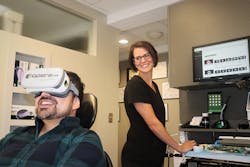OperaVR virtual reality system by OperaDDS
Dealing with apprehensive and anxious patients is no walk in the park. We do it daily, and it never gets any easier. Sometimes we need sedation and anxiolytics. Sometimes nitrous oxide is the key. However, we can’t rely solely on pharmaceutical means of dealing with anxious patients. Some patients can’t tolerate medications, and sometimes we can’t sedate because of emergencies and unplanned procedures. We need other tools in our armamentarium to help. OperaVR can be one of those tools.
It seems as if you can’t consume any kind of media without seeing virtual reality being advertised in some way. Whether for gaming, entertainment, or education, VR seems to be a trend that is here to stay. OperaVR is bringing it to dentistry. Using this system, you can give your patient an immersive, soothing experience. The folks at OperaDDS call it “digital nitrous.” I love that term! We know what we are getting with nitrous—an experience that takes the edge off for our patients but is not sedation. The same thing applies here. We are hoping to relieve patients’ anxiety and apprehension the same way nitrous oxide would but nonpharmaceutically.
OperaVR is a self-contained VR unit that is adjustable to fit just about any patient. The patient slides it over his or her head and positions it comfortably, just as with any other VR unit you have seen advertised. There is a headphone jack on the bottom of the unit. Using the patient’s own headphones or some single-use headphones (which you can get online), audio can be added to the patient’s experience.
The OperaVR unit connects to your office Wi-Fi to receive its data. Using a portal web page, you or your assistant can curate the “digital nitrous” playlist that will run for your patient. Most of the experiences that can be played for your patient are designed to promote relaxation. You will find landscapes, cityscapes, underwater scenes, and even surrealist experiences. In addition, there are post-op instructions for restorative and hygiene procedures. Talk about catching patients while they are a captive audience!
OperaVR can serve as a marketing initiative as well. Many prospective patients will not have heard about the possibility of using VR to relieve dental anxiety. Bryan Laskin, DDS, the inventor, has discussed this in many media outlets. It takes about 30 seconds to get OperaVR up and running. I have found that patients enjoy it, and it seems to make their appointments easier.
Similar to a nitrous mask, the VR mask can be a little difficult for me to maneuver around in some situations. Anterior teeth, especially on the left (I am right-handed) are somewhat tough to work on with OperaVR in place. Other than that, I find it much easier to work with than nitrous oxide. I don’t have to worry about an additional consent and health history form, I don’t have to wait forever for it to take effect, and when we are done, I don’t have to slowly bring the patient back up with oxygen.
Give OperaVR a try and see for yourself. I think using VR for relaxation and patient education has a bright future in dentistry! Opposite-field double down the first-base line for OperaVR!
PrepStart H2O Hydro Abrasion System by Zest Dental Solutions
This morning I saw a teenager for a few direct restorations. It was a basic restorative appointment. A third-year dental student could have done these restorations. I placed two restorations for small occlusal caries, a couple for early enamel caries in fissures, and three sealants. For us, this is a simple half hour of work. To this teenage patient, I might as well have been extracting all her teeth and placing 28 implants, all while zapping her with a cattle prod. She was that apprehensive.
I routinely anesthetize for cases like this. Having a piece of equipment that could help me avoid anesthetizing would be a dream. A hard-tissue laser can absolutely help us bypass the need for anesthetic, but those come with a significant price tag. Unfortunately, dentistry has all but forgotten about something that can help without breaking the bank: air abrasion, today more than ever, has a place in our restorative dental practices.
With my apprehensive teenager this morning, air abrasion made perfect sense. I could use it without anesthetic to prep out the occlusal caries. It easily cleaned out the early enamel pit and fissure caries. Finally, it thoroughly cleaned out the plaque and debris from the other fissures that I subsequently sealed. I was able to do the entire case, except for minor bite adjustments, with air abrasion. The unit I used was small, inconspicuous, and simple to use. The PrepStart H2O from Zest Dental Solutions has been a great asset to my practice the past several months.
This little powerhouse hooks up via a quick-connect air line to your delivery unit. No power is needed, and the on-board water tank prevents the need for a water line. This unit can help you painlessly remove diseased tooth structure, stain, and debris with 27- or 50-micron aluminum oxide powder media. The cone of fine water spray surrounds the abrasive air spray, capturing virtually all the dust. This makes air abrasion much more comfortable for the patient.
The PrepStart H2O has controls for powder-to-air mixture, pressure, and water spray volume. Using these controls, you can dial in the level of abrasion you need to treat the case. I have used the PrepStart H2O mainly for what I described earlier—smaller occlusal lesions, preventive resin restorations, and sealants. I have also used it to roughen tooth structure for bonding on Class Vs. Be a little careful when using aluminum oxide around the gingiva because it can create a little sulcular bleeding. I have also used it to enhance bonding on Class II restorations prepped traditionally with a handpiece and bur. Having the ability to enhance bonding via air abrasion in the mouth is a godsend.
I could certainly perform many of these tasks and more with a hard-tissue laser. However, the PrepStart H2O can do so much for a 20th of the cost of an “inexpensive” hard-tissue laser. If you would like to do more minimally invasive dentistry, which is often anesthetic free, and do so without committing tens of thousands of dollars to a new piece of equipment, the PrepStart H2O is for you. I have this little dynamo on a cart with wheels in my office. You had better believe that it gets wheeled all over my office! Solo home run for Zest Dental Solutions on the PrepStart H2O!
Omnichroma resin-based restorative material by Tokuyama
On January 15, 2018, Newton Fahl Jr., DDS, MS, sent me a message on Facebook. I was stunned to see his name in my inbox. He is, in my opinion and many others’, dentistry’s greatest living artist at direct restorations. He was thanking me for mentioning him in an article. I couldn’t believe he even knew my name, much less that he had sent me a note! Recently, Seattle Study Club posted a 15-minute practice inspiration video lecture by him, and I was once again reminded of his greatness.
Unfortunately, I am not Dr. Fahl. Most of my restorations don’t get layered with different opacities of resin composite; some do, but I mostly use a single body shade for anteriors. For posteriors, heck—normally we don’t even take a shade for direct restorations, which means sometimes they match and sometimes they don’t. Tokuyama recently debuted a new composite material for us mere mortal non-Newtonians.
Omnichroma is a resin composite that comes in one single shade. It generates its shade based on the surrounding tooth color, rather than simply blending, and it looks great. When first placed in a preparation, you will notice its Tokuyama DNA. Tokuyama resin composites handle superbly and are, quite frankly, a delight to work with. Omnichroma is no different.
From an esthetic standpoint, I noticed something interesting about Omnichroma. When you first dispense it into a preparation and begin to sculpt it, you will notice the shade seems off. However, as it cures, the shade changes and it blends into the tooth around it. It is quite interesting to see.
For posterior use, Omnichroma is an excellent choice. It has worked well every time I have used it in the posterior. After curing, occlusal adjustment, and minor polishing, Omnichroma blends extremely well. Even in Class V situations in the posterior, it has blended well.
I have used Omnichroma in the anterior in select situations using Omnichroma Blocker. Omnichroma Blocker is a supplementary material designed to reduce shade-matching interference caused by a lack of surrounding dentition or by other parts of the mouth. I have used Omnichroma in the anterior on patients with lots of caries who already have previous restorations in their anterior teeth. You know these patients—they have so many different shades on anterior teeth that it would be difficult to pick just one. In those cases, Omnichroma has worked well for me in the anterior. I have yet to use Omnichroma in a highly esthetically demanding case for an anterior tooth.
Simplicity, in both procedure and supply stock and inventory, is a huge advantage of Omnichroma. There’s no need to stress and spend time trying to pick the perfect shade. Omnichroma will blend in well. We all have fishing tackle boxes full of obscure shades of composite we never use. We still need some of that for anteriors, but with Omnichroma, we can cover a lot of it with one SKU. This should make your life and your assistant’s life easier, while saving you money on supply costs.
Omnichroma needs to be seen to be believed. You need to get some in your hands and test your limits with it. I think you will be pleasantly surprised. Double into the left-field corner for Omnichroma!










